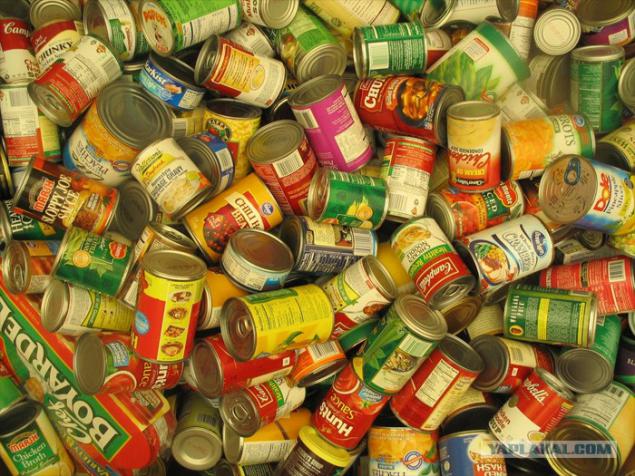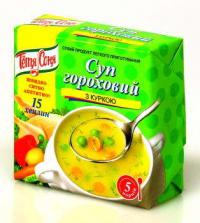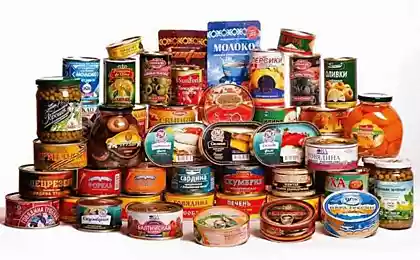861
Everything you wanted to know about the canned goods,
September 3 is the birthday of canned food - in 1812 in England, he began working first cannery. The very same technology was introduced three years earlier in France, and the secrets of preserving food people have known and used for thousands of years.
Will be 16 photos.

The world's first canned food - duck, roasted with olive oil, and embalmed in a clay bowl two halves glued together - found during the excavation of the tomb of Tutankhamen in Egypt. After 3 thousand years they have been conditionally fit for human consumption. People, of course, did not try the meat, but dogs, according to the legend, it is quite well fed. Meanwhile, the most ancient "canned", created by nature, it has been found in the last century in the United States. In lies at a depth of about one hundred meters a transparent reservoir rock salt builders, tunneling, we saw some frozen fishes. Breaking lumps, people found out that the fish is quite soft and, apparently edible. But as soon as they pulled into the fresh air, they immediately turned to stone. Scientists have suggested that these "canned" is not less than 10 thousand years.

In addition to canning Egyptians successfully engaged in the North American Indians, which was ground meat into a powder, mixed it with spices and up to six months was stored in leather bags, calling a product "pemmican". In addition, since ancient times people have been known techniques of drying, smoking and pickling, which also allows you to store meat, fish or vegetables for a long time.

Production of dried soup with spices and without spices and a half pounds each class & quot ;. Such an order made the outstanding Russian scientist Mikhail Lomonosov, when in 1763 as the official responsible for the organization of the expedition, which was to study the polar regions and the Northern Sea Route. A first cannery in our country only opened in 1870 - 58 years later than in Europe. In St. Petersburg, for the army issued by the Bank with roast beef, meat with peas, stew, pea soup and porridge. For the general public to this range of added canned fish.

Invention of the modern world owes to the Paris canned cooks and confectioners Nicolas François Appert. Emperor Napoleon and called him - "do-gooder" - for the fact that in 1809 he was in a sealed glass container and iron for eight months has managed to preserve meats, fruits, vegetables and broth. Counting on commercial success, Upper soon opened in Paris the first store in the world "Different meal sold in bottles and boxes." However, all his banks were too heavy and cumbersome, and the cost of "eatables" and its price on the shelves exceeds the limit. However, this did not prevent the French canned ensure their soldiers in the war against Russia. Russian soldiers, as legend has it, banks are open feared captured, believing that within lyagushatina. The most daring, for that matter, ever, commander Kutuzov appeared personally to determine that it was a lamb.

Impetus to the development of the market of canned food in the middle of the XIX century invention gave tin English mechanic Peter Durand. The lightweight design makes it convenient to transport - and soon preserves a considerable number of steel exported to British colonies. However, there was in these cans and serious drawback - they can be opened only with a hammer and chisel. Then the technology is optimized, taking thinner tin and soldered steel cover accurately. In 1860 he was finally invented the can opener, and in the middle of the last century, the American engineer Ermanno Frazee invented banks with a key to open. At this point he pushed a trip with friends on the nature. They seized the beer in an aluminum container, but did not bring a special knife. By the way, progress does not stand still - so now entered the market with built-in cans knife for slicing content.

The Soviet Union was probably the world leader in the production of canned food. And it's not that only one Capital Works produced in a year to 100 million cans, and these companies there were dozens. The main thing - the widest assortment includes about vommisot types of meat, fish, vegetables, fruit preserves and juices. It was amidst this diversity and many exotics - such as canned char, nyarki, coho salmon, chinook salmon, pork bacon with beans, quince puree. By the way, from the Far East still exporting canned crab.

Famous pilchards in tomato sauce for half a century made in a completely unique recipe. Fishes caught tons, salted still on board the trawler and quickly transported to the factory. Here they are lightly sprinkled with flour and dipped in hot vegetable oil. Then the caring hands of workers pilchards fish combines rammed into cans and poured a small - 10 per cent - a layer of tomato sauce. Cost jar - 33-35 cents, which is largely due to the popularity of these cans.

In compiled by Forbes ten most expensive and unusual canned food was a place rolled up in banks scorpion, snail, bamboo worms, marine mollusks, chestnuts, Chinese truffles, foie gras, meat Alligator and Cobra and the most ordinary black caviar at a price almost 9, 5 thousand rubles per 125 grams. In other similar ratings can be found canned silkworm larvae Korean, Swedish fermented herring, Scandinavian deer pâté, American chicken legs (they are placed in a tin bucket entirely) and possum in a cream sauce, and armadillo ... with whipped cream.

Among the most amazing canned food recently took the "air". First appeared in the West "air traffickers" took over the scam, then - for the freaks, but as a result the business has spread. They say, in Iceland, in addition to local air, you can buy a jar with a "rain" and "mist". Meanwhile, a businessman from St. Petersburg 10 years ago not only adopted the Western idea and launched a similar business, but also received a patent which, according to him, gives an exclusive right to trade in souvenir packing air throughout Russia. It all began with St. Petersburg, then banks have to roll up the air in Moscow, Sochi, Kostroma, Lipetsk, Kazan, and a dozen Russian cities. Price completely empty cans - from 300 to 600 rubles.

Canned fish for astronauts is a kind of jelly - to juice or oil is not sprayed in weightlessness. For cans "table" made special socket - here they are warmed up, here they are opened by conventional tin knives.

Women who want to lose weight magazines recommend canned lentils, beans, salmon, mackerel, pineapple.

The surprising discovery was made by scientists of Krasnoyarsk State Trade and Economic Institute. During the experiments, they found that a canned fish contain more mineral acids than in the cooked fish. Thus, in acetic marinated herring oil pouring their content twice higher than in the fresh.

In the town of Mamonovo, Kaliningrad region is a monument Baltic sprats. As the placed near the inscription, "This is the jewel in the crown of the fishing industry." By the way, the same fish in tin dedicated the monument to Latvian Liepaja, and beef stew immortalized in the Bosnian capital Sarajevo.

Among collectors isolated fishefilistov - those who collect the labels and stickers on jars of canned fish and caviar. With a special interest in the Internet looking for labels on canned food, which was used by German soldiers during the Second World War. However, here it is more about not about fishefilistah, but the military-historical re-enactors.

The word "canned" has several meanings, in addition to the main one. First, the earlier so-called special glasses that protect your eyes from bright light and dust. During the memorable events in Afghanistan, soldiers-internationalists canned called zinc coffins with the remains of dead Soviet soldiers. In medical slang so designate patients in the surgical department at the conservative treatment. And the hair dryer - a person who convicts take with him to escape to eat ... later. Confirmation of the common people in the version could not be found in any dictionary of criminal slang and thieves. But it was the basis of the film "Canned" directed by Yegor Konchalovsky.

Source:
Will be 16 photos.

The world's first canned food - duck, roasted with olive oil, and embalmed in a clay bowl two halves glued together - found during the excavation of the tomb of Tutankhamen in Egypt. After 3 thousand years they have been conditionally fit for human consumption. People, of course, did not try the meat, but dogs, according to the legend, it is quite well fed. Meanwhile, the most ancient "canned", created by nature, it has been found in the last century in the United States. In lies at a depth of about one hundred meters a transparent reservoir rock salt builders, tunneling, we saw some frozen fishes. Breaking lumps, people found out that the fish is quite soft and, apparently edible. But as soon as they pulled into the fresh air, they immediately turned to stone. Scientists have suggested that these "canned" is not less than 10 thousand years.

In addition to canning Egyptians successfully engaged in the North American Indians, which was ground meat into a powder, mixed it with spices and up to six months was stored in leather bags, calling a product "pemmican". In addition, since ancient times people have been known techniques of drying, smoking and pickling, which also allows you to store meat, fish or vegetables for a long time.

Production of dried soup with spices and without spices and a half pounds each class & quot ;. Such an order made the outstanding Russian scientist Mikhail Lomonosov, when in 1763 as the official responsible for the organization of the expedition, which was to study the polar regions and the Northern Sea Route. A first cannery in our country only opened in 1870 - 58 years later than in Europe. In St. Petersburg, for the army issued by the Bank with roast beef, meat with peas, stew, pea soup and porridge. For the general public to this range of added canned fish.

Invention of the modern world owes to the Paris canned cooks and confectioners Nicolas François Appert. Emperor Napoleon and called him - "do-gooder" - for the fact that in 1809 he was in a sealed glass container and iron for eight months has managed to preserve meats, fruits, vegetables and broth. Counting on commercial success, Upper soon opened in Paris the first store in the world "Different meal sold in bottles and boxes." However, all his banks were too heavy and cumbersome, and the cost of "eatables" and its price on the shelves exceeds the limit. However, this did not prevent the French canned ensure their soldiers in the war against Russia. Russian soldiers, as legend has it, banks are open feared captured, believing that within lyagushatina. The most daring, for that matter, ever, commander Kutuzov appeared personally to determine that it was a lamb.

Impetus to the development of the market of canned food in the middle of the XIX century invention gave tin English mechanic Peter Durand. The lightweight design makes it convenient to transport - and soon preserves a considerable number of steel exported to British colonies. However, there was in these cans and serious drawback - they can be opened only with a hammer and chisel. Then the technology is optimized, taking thinner tin and soldered steel cover accurately. In 1860 he was finally invented the can opener, and in the middle of the last century, the American engineer Ermanno Frazee invented banks with a key to open. At this point he pushed a trip with friends on the nature. They seized the beer in an aluminum container, but did not bring a special knife. By the way, progress does not stand still - so now entered the market with built-in cans knife for slicing content.

The Soviet Union was probably the world leader in the production of canned food. And it's not that only one Capital Works produced in a year to 100 million cans, and these companies there were dozens. The main thing - the widest assortment includes about vommisot types of meat, fish, vegetables, fruit preserves and juices. It was amidst this diversity and many exotics - such as canned char, nyarki, coho salmon, chinook salmon, pork bacon with beans, quince puree. By the way, from the Far East still exporting canned crab.

Famous pilchards in tomato sauce for half a century made in a completely unique recipe. Fishes caught tons, salted still on board the trawler and quickly transported to the factory. Here they are lightly sprinkled with flour and dipped in hot vegetable oil. Then the caring hands of workers pilchards fish combines rammed into cans and poured a small - 10 per cent - a layer of tomato sauce. Cost jar - 33-35 cents, which is largely due to the popularity of these cans.

In compiled by Forbes ten most expensive and unusual canned food was a place rolled up in banks scorpion, snail, bamboo worms, marine mollusks, chestnuts, Chinese truffles, foie gras, meat Alligator and Cobra and the most ordinary black caviar at a price almost 9, 5 thousand rubles per 125 grams. In other similar ratings can be found canned silkworm larvae Korean, Swedish fermented herring, Scandinavian deer pâté, American chicken legs (they are placed in a tin bucket entirely) and possum in a cream sauce, and armadillo ... with whipped cream.

Among the most amazing canned food recently took the "air". First appeared in the West "air traffickers" took over the scam, then - for the freaks, but as a result the business has spread. They say, in Iceland, in addition to local air, you can buy a jar with a "rain" and "mist". Meanwhile, a businessman from St. Petersburg 10 years ago not only adopted the Western idea and launched a similar business, but also received a patent which, according to him, gives an exclusive right to trade in souvenir packing air throughout Russia. It all began with St. Petersburg, then banks have to roll up the air in Moscow, Sochi, Kostroma, Lipetsk, Kazan, and a dozen Russian cities. Price completely empty cans - from 300 to 600 rubles.

Canned fish for astronauts is a kind of jelly - to juice or oil is not sprayed in weightlessness. For cans "table" made special socket - here they are warmed up, here they are opened by conventional tin knives.

Women who want to lose weight magazines recommend canned lentils, beans, salmon, mackerel, pineapple.

The surprising discovery was made by scientists of Krasnoyarsk State Trade and Economic Institute. During the experiments, they found that a canned fish contain more mineral acids than in the cooked fish. Thus, in acetic marinated herring oil pouring their content twice higher than in the fresh.

In the town of Mamonovo, Kaliningrad region is a monument Baltic sprats. As the placed near the inscription, "This is the jewel in the crown of the fishing industry." By the way, the same fish in tin dedicated the monument to Latvian Liepaja, and beef stew immortalized in the Bosnian capital Sarajevo.

Among collectors isolated fishefilistov - those who collect the labels and stickers on jars of canned fish and caviar. With a special interest in the Internet looking for labels on canned food, which was used by German soldiers during the Second World War. However, here it is more about not about fishefilistah, but the military-historical re-enactors.

The word "canned" has several meanings, in addition to the main one. First, the earlier so-called special glasses that protect your eyes from bright light and dust. During the memorable events in Afghanistan, soldiers-internationalists canned called zinc coffins with the remains of dead Soviet soldiers. In medical slang so designate patients in the surgical department at the conservative treatment. And the hair dryer - a person who convicts take with him to escape to eat ... later. Confirmation of the common people in the version could not be found in any dictionary of criminal slang and thieves. But it was the basis of the film "Canned" directed by Yegor Konchalovsky.

Source:























